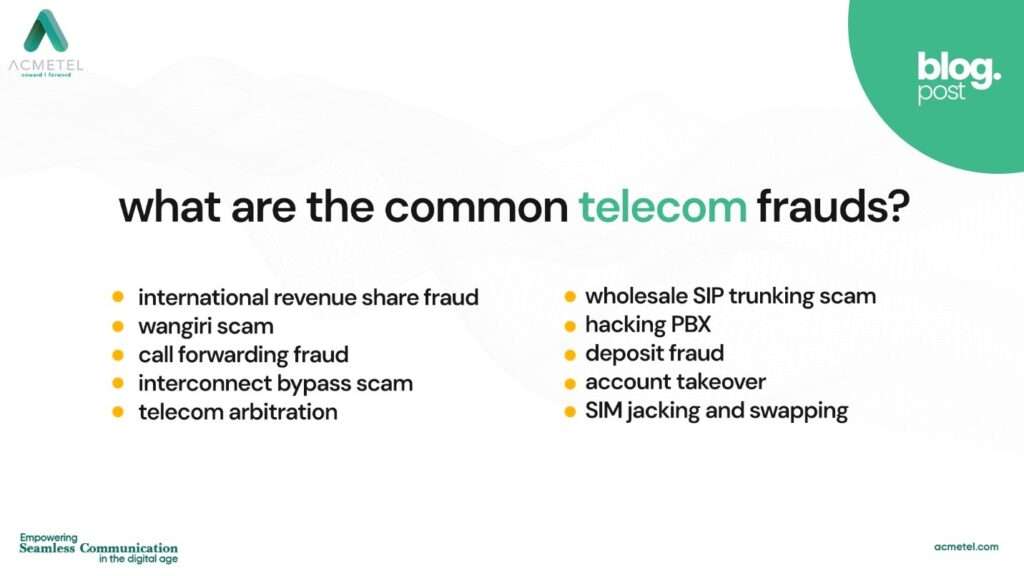Telecommunication Fraud refers to manipulating telecom services intending to gain an unfair advantage over companies. It is often done through deceptive tactics or strategic attacks on mobile phones, cloud systems, and on premise PBX setups. Perpetrators may exploit vulnerabilities such as International Revenue Sharing Fraud (IRSF) or interconnect bypass fraud to capitalize on varying call rates among operators or use premium rates. To maintain the integrity of their services, companies must continuously work to mitigate these risks.
Telecom companies use fraud management as a systematic approach to detect, identify, prevent, and mitigate fraudulent activities within their systems and networks. Fraud Management Services uses strategies, technologies, and processes to identify, analyze, prevent, or respond to fraudulent activities effectively.
How Does Telecommunication Fraud Work?
Telecommunication networks are the most widely used method for data transmission across the globe, making them a significant contributor to consumer electronics revenue. Unfortunately, fraudsters have developed sophisticated tools and strategies to exploit these networks for their gain. Telecom fraud is unique in that it is often anticipated but causes financial losses for operators without fraud management systems. Telecom companies also offer their services for resale across various networks and carriers, which increases the challenge of detecting and preventing fraud. With the increasing accessibility of mobile network management technology, larger telecom operators are also becoming vulnerable to second-hand fraud that is challenging to detect.

There are various forms of telecom fraud. Let’s look at each one to prevent them from occurring again.
1: International Revenue Share Fraud
Due to International Revenue Share Fraud (IRSF), telecom companies face a significant challenge. As per a report by CFCA, this type of fraud results in substantial financial losses amounting to billions of dollars. Service providers have reported that fraudsters take advantage of premium phone rates.
Let us explain how this works:
- The fraudster leases a premium phone number.
- They then hack into a business’s phone system and initiate multiple calls to the premium rate number. Typically, these phone calls are made to increase the total amount due on the bill.
- The result is substantial phone bills, which the targeted business pays. A significant % of this payment winds up enriching the fraudster’s gains.
- Fraudster calls are made outside regular business hours. Many companies will be aware of the breach once they receive the bill and must settle the high charges.
This challenge emphasizes the need for telecom providers to implement robust fraud management systems.
Wangiri Scam
The “Wangiri” scam is a fraudulent tactic where scammers briefly ring the customer’s phone or use other attention-grabbing methods, prompting the customer to call back. “Wangiri” is a Japanese term that means “one and cut,” it capitalizes on people’s curiosity. However, when customers return the call, they often unknowingly dial an expensive premium number that benefits the fraudsters. This scam highlights the importance of telecom service providers adopting robust telecommunication fraud management systems. Telecom networks rely on these systems to protect customers and maintain integrity.
Call Forwarding Fraud
The call forwarding hack is a more advanced kind of VoIP telecom fraud. Scammers breach a business’s PBX user access web portal in this fraud. By trying to guess a user password, they get into the PBX and set up call forwarding to an expensive long-distance location to profit from IRSF. Afterwards, the hacker calls the compromised account’s phone number, delivering the call to IRSF.
- The fraudster gains entry to the web interface of a PBX or IVR (Interactive Voice Response) system, cracks a user’s login and password, and modifies the account settings to forward calls to a high-cost destination.
- The fraudster calls the compromised number using the regular phone network (PSTN) or VoIP.
- The compromised PBX forwards the call to the service provider’s soft switch.
- The telecom service provider’s switch sends the call to the high-cost destination. Even though the service provider bears the cost of completing these fake calls, they rarely receive payment from the business that owns the compromised PBX.
- The person committing fraud receives some of the profits earned through these deceitful phone calls.
4: Interconnect Bypass Scam
Interconnect Bypass Fraud is also known as GSM Gateway Fraud or Toll Bypass; these fraudulent activities involve rerouting unauthorized traffic to a local operator using a device like SIM Box or GSM Gateway. This approach aims to finalize the call within the local operator’s network, effectively substituting the costly international interconnect with a notably economical routing channel. Fraudsters make a profit by exploiting the difference in expenses. Telecom service providers need to establish robust telecommunication fraud management systems to prevent these illegal activities and ensure the security of their networks. These systems are essential for upholding the integrity of the telecommunications industry.
5: Telecom Arbitration
The extent of damage incurred from this fraudulent activity is contingent upon the variance in call rates across different nations for international calls. Deceptive enterprises position themselves as intermediaries between two telecommunication operators. They assert that they originate calls directly from one nation, yet they reroute them through a different country with more economical calling rates.
6: Wholesale SIP Trunking Scam
Telecom service providers have reported a recent rise in fraudulent wholesale trunking, which has become popular while posing significant challenges in terms of detection. In this scheme, the fraudster profits by selling wholesale trunking services and utilizing stolen credentials to terminate calls. The distinctive characteristic of this type of fraud lies in the high volume of seemingly random calls it generates.
Subscribers have reported tracing such fraudulent activity back to prepaid calling card companies operating VoIP platforms in offshore facilities. Prepaid calling services are well-suited for exploiting this type of fraud due to the absence of caller identification linked to customers. The only traceable connection to the fraudster typically lies in the IP address of the prepaid calling platform.
Unfortunately, geolocation methods are not always effective in identifying the fraudster in these cases. Geolocation services accessed through an internet tunnel hide the valid IP address of the person committing the fraud. The IP address used for the fraudulent activity may be associated with a Virtual Private Network (VPN) service. On the other hand, the prepaid calling platform is located separately. The perpetrator gains access to a subscriber’s login information.
The fraudster’s soft switch registers with the service provider’s soft switch using the stolen username and password.
- A legitimate user initiates a call. The fraudster sends an invite request to the service provider’s soft switch.
- The soft switch routes the call to an international long-distance destination.
Detecting wholesale SIP trunking fraud is challenging but can be done through telecommunication fraud management systems.
7: Hacking PBX
The private exchange is an internal network that connects companies to external telephone networks. It provides number limitation and line-sharing services. However, the rise of IP-based PBX systems has made these private exchanges an attractive target for scammers and hackers. These fraudsters exploit vulnerabilities and gain unauthorized access to manipulate the phone system for their benefit. Therefore, it is essential to have a telecommunication fraud management system in place. Once they gain access, they can make unauthorized calls, login, and cause huge bills.
8: Deposit Fraud
Fraudsters and scammers often use stolen credit cards to purchase prepaid SIM cards, routers, and smartphones. This practice results in substantial financial losses for telecom companies responsible for chargebacks under their warranty. Additionally, this activity makes it more challenging to detect and prevent fraud.
9: Account Takeover
Account takeover fraud occurs when cybercriminals gain unauthorized access to an individual’s online accounts, including bank accounts, email, or social media profiles. They typically use tactics such as phishing, malware, or data breaches to accomplish this. The Telecommunication fraud management system detects and prevents such fraudulent activities.
10: SIM Jacking and Swapping
A common type of fraud involves scammers using a scheme whereby they take control of a customer’s SMS and calling capabilities by transferring the phone number to a new one under their control. As more and more companies use OTP (one-time passwords) for 2FA (2-factor authentication) via text messages or phone calls, fraudsters are attempting to gain access to people’s phone numbers to intercept these OTPs.
The scammer accomplishes the fraudulent activity through an account takeover, where the scammer contacts the customer support of the telecommunications company and requests the transfer of the victim’s number to a new SIM card, which the fraudster then controls. Once completed, the scammers access all the OTPs and SMS verifications required to take over various customer accounts, ranging from social media to other apps. Telecom service providers have verification systems to authenticate the user’s identity when requesting a number change.
How to Identify and Detect Fraud in the Telecommunication Sector?
Professional experts understand that telecom scams can cause significant financial losses and pose tedious problems for telecommunications companies. That’s why they offer comprehensive fraud management services to identify, prevent, and combat the pain and protect businesses of all sizes. Professional telecom service providers implement strict security measures to protect against such threats, including continuously monitoring suspicious behavior and activity. They ensure the safeguarding of your business by immediately detecting and preventing fraudulent calls, texts, and transactions.
Conclusion
Telecom service providers are committed to strengthening their telecommunication fraud management systems and improving verification protocols in response to the ever-changing tactics used by fraudsters. These efforts aim to protect customers from fraudulent activities. As technology and fraudulent schemes evolve, the fight against telecom fraud remains crucial to safeguarding the security and privacy of individuals and organizations.








